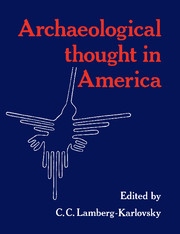Book contents
- Frontmatter
- Contents
- List of illustrations
- Introduction
- Part I History, method, and theory
- 1 History and contemporary American archaeology: a critical analysis
- 2 Aspects of the application of evolutionary theory in archaeology
- 3 The “New Archaeology,” then and now
- 4 Marxism in American archaeology
- 5 Formal approaches in archaeology
- 6 Ideology and evolutionism in American archaeology: looking beyond the economic base
- 7 The present and the future of hunter-gatherer studies
- 8 Paleopathology and the interpretation of economic change in prehistory
- Part II Archaeology in the Americas and beyond
- References
- Index
3 - The “New Archaeology,” then and now
Published online by Cambridge University Press: 06 July 2010
- Frontmatter
- Contents
- List of illustrations
- Introduction
- Part I History, method, and theory
- 1 History and contemporary American archaeology: a critical analysis
- 2 Aspects of the application of evolutionary theory in archaeology
- 3 The “New Archaeology,” then and now
- 4 Marxism in American archaeology
- 5 Formal approaches in archaeology
- 6 Ideology and evolutionism in American archaeology: looking beyond the economic base
- 7 The present and the future of hunter-gatherer studies
- 8 Paleopathology and the interpretation of economic change in prehistory
- Part II Archaeology in the Americas and beyond
- References
- Index
Summary
A review of the arguments and developments that characterized American archaeology during the late 1950s and early 1960s shows that several basic positions were being advocated, and, as a result, subsequent archaeological work has pursued several different directions. Central to the arguments advanced by so-called New Archaeologists in America was the issue of how to accurately give meaning to archaeological observations. This concern, at least during the 1960s, was embedded within arguments that addressed how archaeologists had traditionally given meaning to the archaeological record. The early years of this discussion, which opponents called the “New Archaeology” (generally said with scathing sarcasm), were characterized by attempts to evaluate the validity or accuracy of the propositions that had guided the interpretation of (and the assignment of meaning to) archaeological remains by the leading archaeologists who had been our teachers. The ideas that the New Archaeologists criticized might be thought of as basic aspects of the culture-history view of culture, which dominated the writings of archaeologists during the 1930s, 1940s, and 1950s.
Culture history is first and foremost an idealistic approach to understanding. By idealism I mean “any system or doctrine whose fundamental interpretative principle is ideal” (Runes 1962:136–7). Most anthropologists and archaeologists were not mentalists in that they acknowledged a reality (e.g. historical or environmental) outside of their own minds, but they were idealists in the sense that culture was considered to be a product of the workings of individual minds as those individuals reacted to the events of cultural and natural history.
- Type
- Chapter
- Information
- Archaeological Thought in America , pp. 50 - 62Publisher: Cambridge University PressPrint publication year: 1989
- 7
- Cited by



